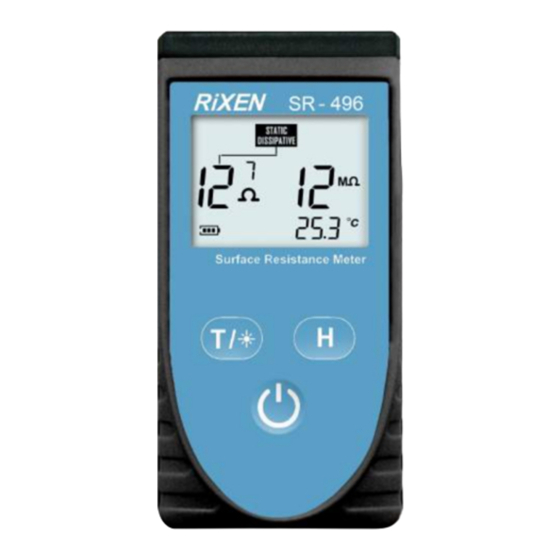
Advertisement
Quick Links
The surface resistance can be measured by attaching two parallel electrodes of the instrument to the surface
of the measured object. Thus you can determine whether the measured object is a conductor, anti-static
material, or an insulator. The instrument is particularly suitable for a variety of anti-static areas.
A. Specifications of SR-496
Resistance Measurement Range
Resistance Measurement Accuracy
Response Time
Temperature Measurement Range
Temperature Measurement Accuracy
Power Supply
Dimension
Weight
B. Material Resistance Range
Conductor
Anti-Static Material
Insulator
※The signal is weak when measure surface resistance of 10
reliable measurement, it is necessary to make environment where electromagnetic interference is small.
During the measurement process, make sure that no person walks within 3 meters.
C. Function
▶ Surface resistance test
▶ Three ways to display the surface resistance or material properties simultaneously
▶ Environment temperature measurement
▶ Temperature unit conversion
▶ Data hold
▶ LCD backlight
▶ Auto turn off
D. LCD Display
(Please see the right photo.)
① Insulation material indicator
② Anti-static material indicator
③ Conductor indicator
④ Resistance value
⑤ Temperature value
⑥ Resistance measurement indicator
⑦ Data hold indicator
⑧ Battery indicator
SR-496 Surface Resistance Meter
Instruction Manual
0.1 x 10
<±10%
Approx. 1 sec.
0℃ ~ +50℃ (+32℉ ~ +122℉)
±1℃ (±1.8℉)
One 9V battery
64 x 35 x 126mm (2.5" x 1.2" x 5.0")
Approx. 156g (battery included)
6
<10
6
11
10
~ 10
12
≧10
3
12
Ω
~ 1.5 x 10
11
Ω or more, in order to ensure stable and
- 1 -
Advertisement

Summary of Contents for Rixen SR-496
- Page 1 SR-496 Surface Resistance Meter Instruction Manual The surface resistance can be measured by attaching two parallel electrodes of the instrument to the surface of the measured object. Thus you can determine whether the measured object is a conductor, anti-static material, or an insulator. The instrument is particularly suitable for a variety of anti-static areas.
- Page 2 Instrument Description (Please see the right photo.) (A) LCD display (B) Conversion of resistance mode and temperature unit (C) Resistance measurement and data hold (D) On/off button and backlight button (E) Ground wire jack (F) Measurement electrode (G) Battery cover F.



Need help?
Do you have a question about the SR-496 and is the answer not in the manual?
Questions and answers